Citroen DS4 RHD 2014.5 1.G Owner's Manual
Manufacturer: CITROEN, Model Year: 2014.5, Model line: DS4 RHD, Model: Citroen DS4 RHD 2014.5 1.GPages: 444, PDF Size: 12.99 MB
Page 271 of 444

269
The spare wheel is installed in the boot under
the floor.
Depending on version, the spare wheel may be
a standard size steel or alloy wheel, or for some
countries it is the "space saver" type.
For access to the spare wheel, refer to the
paragraph "Access to the tools" on the previous
page.
Access to the spare wheel
If your vehicle has an electric parking
brake, only a "space saver" type of
wheel can be stowed in the boot.
Taking out the standard wheel
F Unscrew the yellow central bolt.
F R aise the spare wheel towards you from
the rear.
F
T
ake the wheel out of the boot.
Tyre under-inflation detection
The spare wheel is not fitted with a
sensor. The punctured wheel must
be repaired by a CITROËN dealer or
aqualified workshop.
Practical information
Page 272 of 444
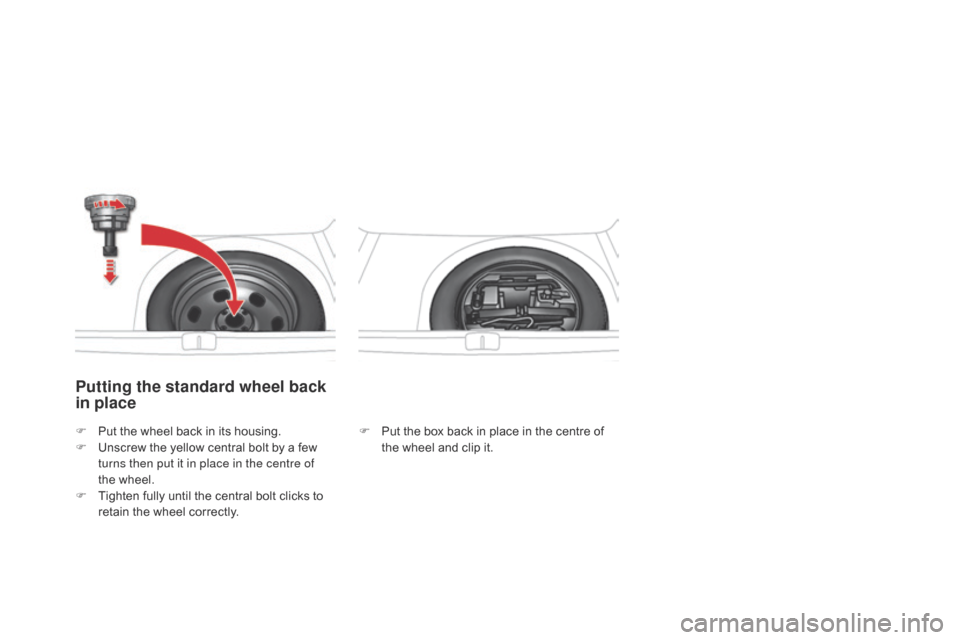
Putting the standard wheel back
in place
F Put the box back in place in the centre of the wheel and clip it.
F
P
ut the wheel back in its housing.
F
U
nscrew the yellow central bolt by a few
turns then put it in place in the centre of
the
wheel.
F
T
ighten fully until the central bolt clicks to
retain the wheel correctly.
Page 273 of 444
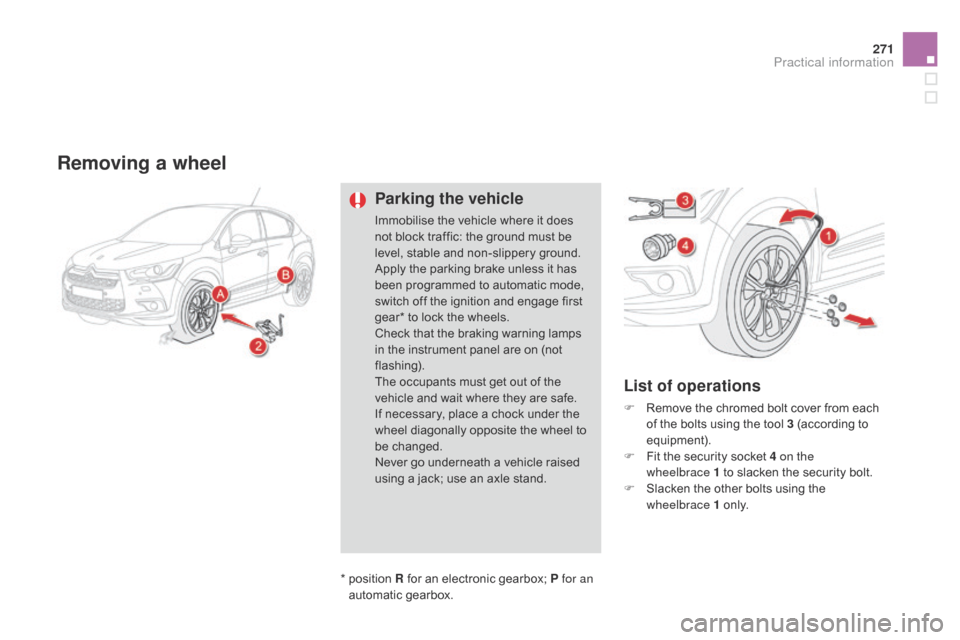
271
Removing a wheel
Parking the vehicle
Immobilise the vehicle where it does
not block traffic: the ground must be
level, stable and non-slippery ground.
Apply the parking brake unless it has
been programmed to automatic mode,
switch off the ignition and engage first
gear* to lock the wheels.
Check that the braking warning lamps
in the instrument panel are on (not
flashing).
The occupants must get out of the
vehicle and wait where they are safe.
If necessary, place a chock under the
wheel diagonally opposite the wheel to
be changed.
Never go underneath a vehicle raised
using a jack; use an axle stand.
List of operations
F Remove the chromed bolt cover from each of the bolts using the tool 3 (according to
equipment).
F
F
it the security socket 4 on the
wheelbrace
1 to slacken the security bolt.
F
S
lacken the other bolts using the
wheelbrace 1 o n l y.
*
p
osition R for an electronic gearbox; P for an
automatic gearbox.
Practical information
Page 274 of 444
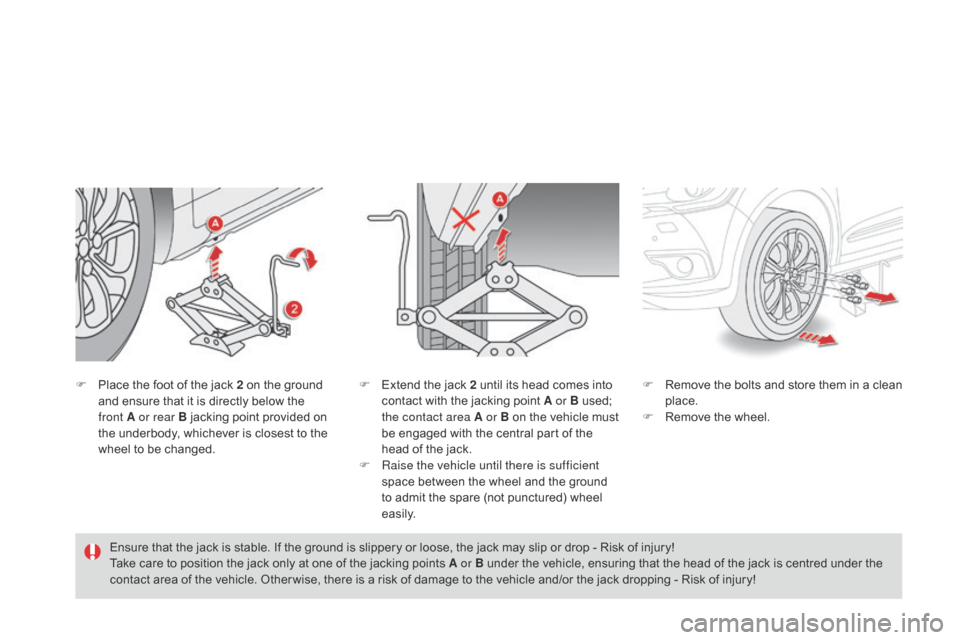
F Place the foot of the jack 2 on the ground and ensure that it is directly below the
front
A or rear B jacking point provided on
the underbody, whichever is closest to the
wheel to be changed. F
R emove the bolts and store them in a clean
place.
F
R
emove the wheel.
Ensure that the jack is stable. If the ground is slippery or loose, the jack may slip or drop - Risk of injury!
Take care to position the jack only at one of the jacking points A or B under the vehicle, ensuring that the head of the jack is centred under the
contact area of the vehicle. Other wise, there is a risk of damage to the vehicle and/or the jack dropping - Risk of injury! F
E xtend the jack 2 until its head comes into
contact with the jacking point A or B used;
the contact area A or B on the vehicle must
be engaged with the central part of the
head of the jack.
F
Ra
ise the vehicle until there is sufficient
space between the wheel and the ground
to admit the spare (not punctured) wheel
easily.
Page 275 of 444

273
Fitting a wheel
Fitting a steel or "space-
saver" spare wheel
If your vehicle is fitted with alloy
wheels, when tightening the bolts on
fitting it is normal to notice that the
washers do not come into contact with
the steel or "space-saver" spare wheel.
The wheel is secured by the conical
contact of each bolt.
List of operations
F Put the wheel in place on the hub.
F S crew in the bolts by hand to the stop.
F
P
re-tighten the security bolt using the
wheelbrace 1 fitted with the security
socket 4.
F
P
re-tighten the other bolts using the
wheelbrace 1 o n l y.
After changing a wheel
To store the punctured wheel in the
boot correctly, first remove the central
c ove r.
When using the "space-saver" type
spare wheel, do not exceed 50 mph
(80
km/h).
Have the tightening of the bolts and the
pressure of the spare wheel checked
by a CITROËN dealer or a qualified
workshop without delay.
Have the punctured wheel repaired and
replace it on the vehicle as soon as
possible.
Practical information
Page 276 of 444

F Lower the vehicle fully.
F F old the jack 2 and detach it. F
T ighten the security bolt using the
wheelbrace 1 fitted with the security
socket
4 .
F
T
ighten the other bolts using the
wheelbrace 1 o n l y.
F
R
efit the chromed bolt covers on each of
the bolts (according to equipment).
F
S
tore the tools in the box.
Page 277 of 444
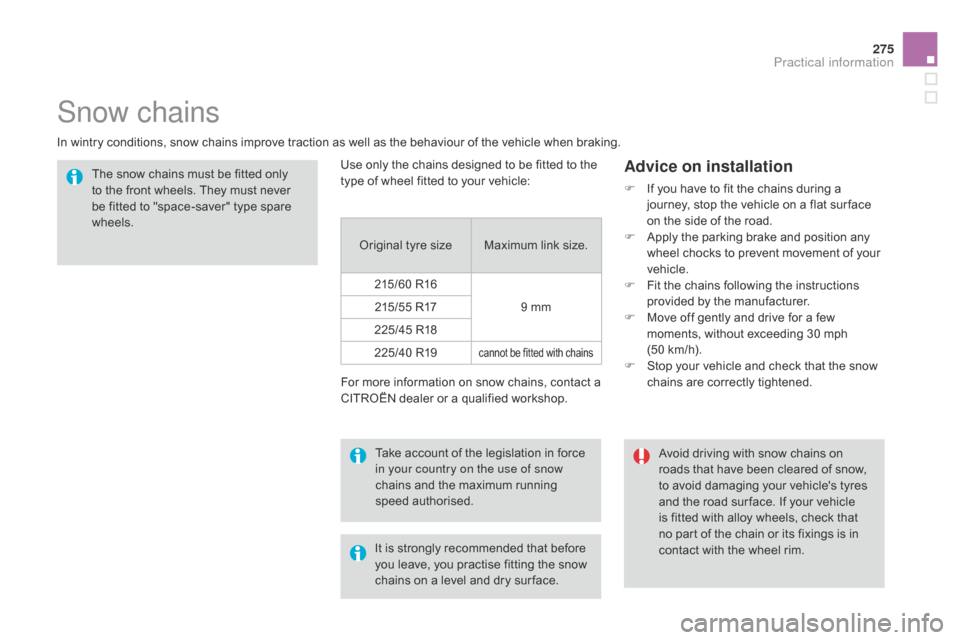
275
Snow chains
In wintry conditions, snow chains improve traction as well as the behaviour of the vehicle when braking.The snow chains must be fitted only
to the front wheels. They must never
be fitted to "space-saver" type spare
wheels.
For more information on snow chains, contact a
CITROËN dealer or a qualified workshop.
Advice on installation
F If you have to fit the chains during a journey, stop the vehicle on a flat sur face
on the side of the road.
F
A
pply the parking brake and position any
wheel chocks to prevent movement of your
vehicle.
F
F
it the chains following the instructions
provided by the manufacturer.
F
M
ove off gently and drive for a few
moments, without exceeding 30 mph
(50
km/h).
F
S
top your vehicle and check that the snow
chains are correctly tightened.
Avoid driving with snow chains on
roads that have been cleared of snow,
to avoid damaging your vehicle's tyres
and the road sur face. If your vehicle
is fitted with alloy wheels, check that
no part of the chain or its fixings is in
contact with the wheel rim.
Take account of the legislation in force
in your country on the use of snow
chains and the maximum running
speed authorised.
Use only the chains designed to be fitted to the
type of wheel fitted to your vehicle:
Original tyre size Maximum link size.215/60 R16 9 mm
215/55 R17
225/45 R18
225/40 R19
cannot be fitted with chains
It is strongly recommended that before
you leave, you practise fitting the snow
chains on a level and dry sur face.
Practical information
Page 278 of 444
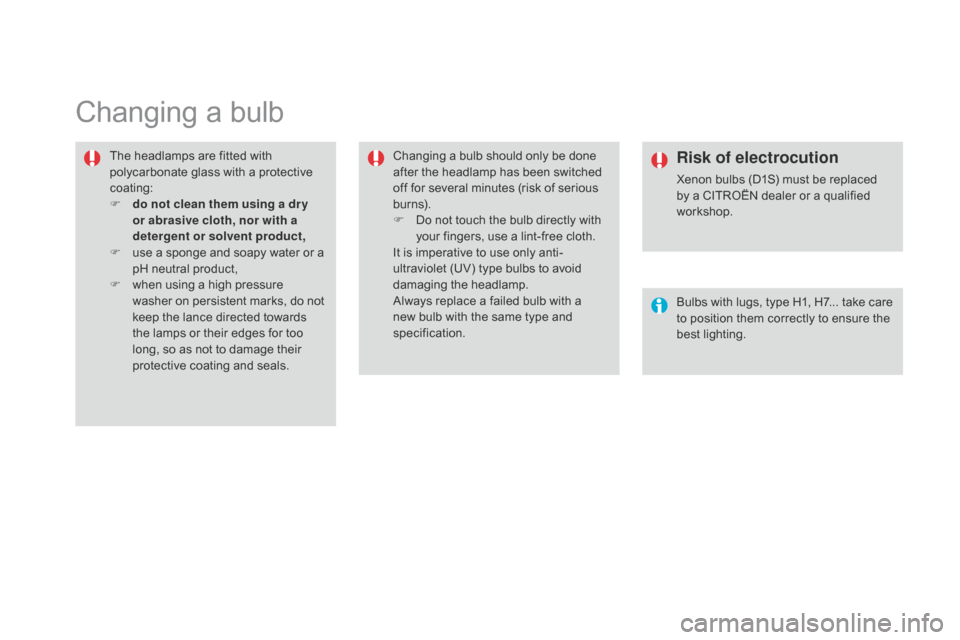
Changing a bulb
The headlamps are fitted with
polycarbonate glass with a protective
coating:
F
d
o not clean them using a dr y
or abrasive cloth, nor with a
detergent or solvent product,
F
u
se a sponge and soapy water or a
pH neutral product,
F
w
hen using a high pressure
washer on persistent marks, do not
keep the lance directed towards
the lamps or their edges for too
long, so as not to damage their
protective coating and seals. Changing a bulb should only be done
after the headlamp has been switched
off for several minutes (risk of serious
burns).
F
D
o not touch the bulb directly with
your fingers, use a lint-free cloth.
It is imperative to use only anti-
ultraviolet (UV) type bulbs to avoid
damaging the headlamp.
Always replace a failed bulb with a
new bulb with the same type and
specification.Risk of electrocution
Xenon bulbs (D1S) must be replaced
by a CITROËN dealer or a qualified
workshop.
Bulbs with lugs, type H1, H7... take care
to position them correctly to ensure the
best lighting.
Page 279 of 444
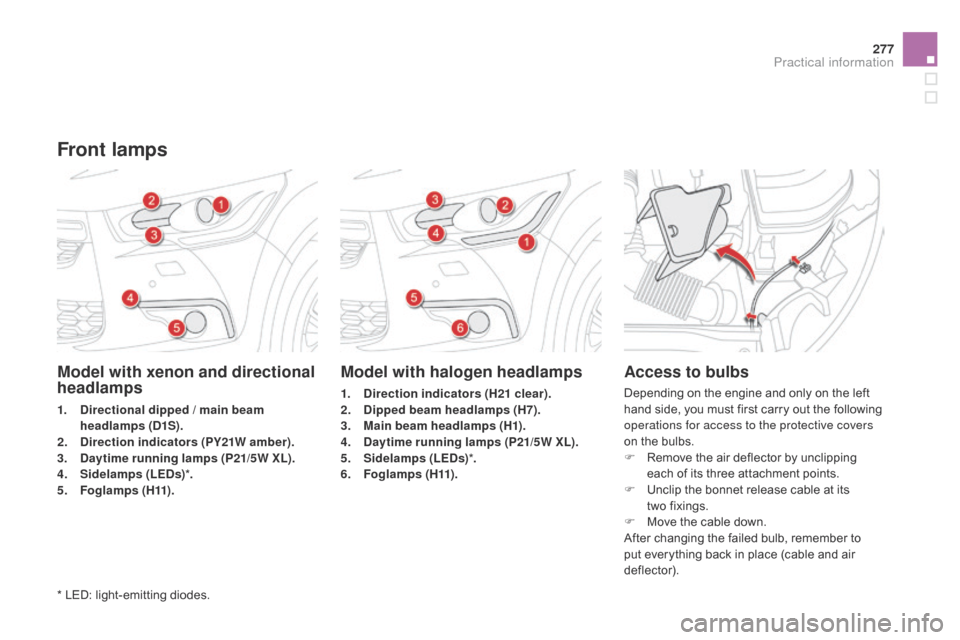
277
Model with xenon and directional
headlamps
1. Directional dipped / main beam headlamps (D1S).
2.
D
irection indicators (PY21W amber).
3.
D
aytime running lamps (P21/5W XL).
4.
S
idelamps (LEDs) *.
5.
F
o g l a m p s ( H11) .
Model with halogen headlamps
1. Direction indicators (H21 clear).
2. D ipped beam headlamps (H7).
3.
M
ain beam headlamps (H1).
4.
D
aytime running lamps (P21/5W XL).
5.
S
idelamps (LEDs) *.
6.
F
o g l a m p s ( H11) .
Access to bulbs
Depending on the engine and only on the left
hand side, you must first carry out the following
operations for access to the protective covers
on the bulbs.
F
R
emove the air deflector by unclipping
each of its three attachment points.
F
U
nclip the bonnet release cable at its
two
fixings.
F
M
ove the cable down.
After changing the failed bulb, remember to
put everything back in place (cable and air
deflector).
Front lamps
* LED: light-emitting diodes.
Practical information
Page 280 of 444

Changing dipped beam headlamp
bulbs (on models with halogen
headlamps)
F Remove the protective cover by pulling the tab.
F
D
isconnect the connector.
F
S
pread the springs to release the bulb.
F
E
xtract the bulb and change it.
To reassemble, carry out these operations in
reverse order.
Changing direction indicator
bulbs
When refitting, close the protective
cover carefully to preserve the sealing
of the headlamp.
Amber coloured bulbs, such as the
direction indicators, must be replaced
with bulbs of identical specifications
and colour.
Rapid flashing of the direction indicator
warning lamp (right or left) indicates the
failure of a bulb on that side.
Model with Xenon headlamps
F
R
emove the protective cover by pulling its
tongue.
F
T
urn the bulb holder a quarter turn and pull
it out.
F
T
urn the bulb a quarter turn and replace it.
To reassemble, carry out these operations in
reverse order.
Model with halogen headlamps
F
T
urn the bulb holder a quarter of a turn and
extract it.
F
P
ull out the bulb and change it.
To reassemble, carry out these operations in
reverse order.